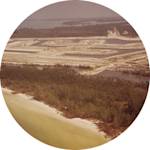The Alvarez Hypothesis
66 million BCE • Italy, Denmark, and New Zealand
In 1977, geologist Walter Alvarez, while studying limestone rock in Gubbio, Italy, discovered a distinct boundary marked by a thin layer of red clay between the Cretaceous and Tertiary periods. This clay layer, revealed to be rich in iridium, provided evidence supporting the Alvarez Hypothesis that a massive asteroid impact caused the mass extinction event, known as "the Great Dying," around 66 million years ago.
"Platinum metals are depleted in the earth's crust relative to their cosmic abundance; concentrations of these elements in deep-sea sediments may thus indicate influxes of extraterrestrial material. Deep-sea limestones exposed in Italy, Denmark, and New Zealand show iridium increases of about 30, 160, and 20 times, respectively, above the background level at precisely the time of the Cretaceous-Tertiary extinctions, 65 million years ago. Reasons are given to indicate that this iridium is of extraterrestrial origin, but did not come from a nearby supernova. A hypothesis is suggested which accounts for the extinctions and the iridium observations. Impact of a large earth-crossing asteroid would inject about 60 times the object's mass into the atmosphere as pulverized rock; a fraction of this dust would stay in the stratosphere for several years and be distributed worldwide. The resulting darkness would suppress photosynthesis, and the expected biological consequences match quite closely the extinctions observed in the paleontological record."
Luis W. Alvarez, Walter Alvarez, Frank Asaro, and Helen V. Michel, "Extraterrestrial Cause for the Cretaceous-Tertiary Extinction," Science 208, no. 4448 (June 6, 1980): abstract.
Image: Shane.torgerson, CC BY 3.0, via Wikimedia Commons


Learn about Maya Lin’s fifth and final memorial: a multi-platform science based artwork that presents an ecological history of our world - past, present, and future.

Discover ecological histories and stories of former abundance, loss, and recovery on the map of memory.

Learn how we can reduce our emissions and protect and restore species and habitats – around the world.

See how art can help us rethink the problems we face, and give us hope that each one of us can make a difference.

Help make a global memorial something personal and close to home. Share your stories of the natural world.


